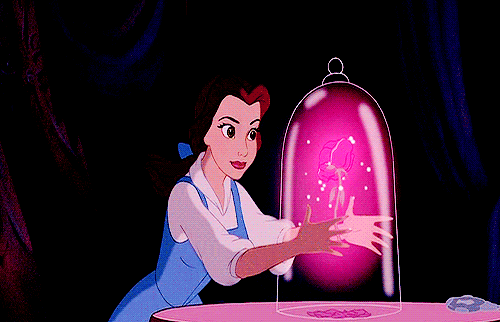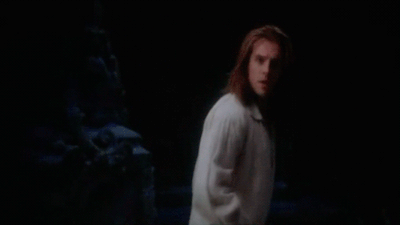
Magic and Religion
But I say, walk by the Spirit, and you will not gratify the desires of the flesh. -Galatians 5:16
In many situations religion may be said to be magical. “Some scholars have equated magic and religion and refer to ‘magico-religious acts and beliefs’” (Stark 102) In Beauty and the Beast however, magic is a tangible, physical power.

Belle looking into the magic mirror, Beauty and the Beast (1991)


Belle looking at the enchanted rose in the 2017 version (top) and the 1991 version (bottom)
But what does magic have to do with religion? As previously discussed, a critical purpose for most religions (including christianity) is to reveal or further understand what it means to be a human. “'Magic’ seems to have originated as a term to describe the practices of an ‘other’, which gets us to examine who ‘we’ really are.” (Graham 255) Therefore, the magical aspects of Beauty and the Beast can be seen as a religious theme, as it is describing the practices of an "other", such as God or Christ, within the story.

Although in this case, it is not only God who is 'magical', but the Enchantress- known in the 2017 version of Beauty and the Beast as Agathe.

The Enchantress' Connection to the Divine
Only two sources of power exist in the universe: those that originate with God, and those that God has allowed Satan to control. -Job 1:12

"Once upon a time in a faraway land, a young prince lived in a shining castle. Although he had everything his heart desired, the prince was spoiled, selfish, and unkind. But then, one winter's night, an old beggar woman came to the castle and offered him a single rose in return for shelter from the bitter cold. Repulsed by her haggard appearance, the prince sneered at the gift and turned the old woman away, but she warned him not to be deceived by appearances, for beauty is found within. And when he dismissed her again, the old woman's ugliness melted away to reveal a beautiful enchantress. The prince tried to apologize, but it was too late, for she had seen that there was no love in his heart. And as punishment, she transformed him into a hideous beast and placed a powerful spell on the castle and all who lived there.
Ashamed of his monstrous form, the beast concealed himself inside his castle, with a magic mirror as his only window to the outside world. The rose she had offered was truly an enchanted rose which would bloom until his 21st year. If he could learn to love another and earn her love in return by the time the last petal fell, then the spell would be broken. If not, he would be doomed to remain a beast for all time. As the years passed, he fell into despair and lost all hope for who could ever learn to love a beast?" Beauty and the Beast (1991)

Agathe revealing herself as an angelic enchantress in the 2017 version of this movie
If only two sources of magical power exist: God's power & Satan's power, then which of these two is Agathe using to summon her powers? I would argue for her connection to God.

Agathe reversing the curse and ressurecting the Beast in the 2017 version of this movie
Throughout these movies, the enchantress acts with christian morals: she curses the Beast to teach him a lesson about hospitality. "Most, if not all, religious traditions urge hospitality towards strangers." (Pinsky 143) As well as teaching him the power of true love, by removing his outer beauty; forcing him to find beauty within himself, and therefore making him a better person.

Agathe when she finds Maurice and saves him from the forest
Agathe is also kind to those who are innocent: “She is revealed to be saintly and charitable when she rescues Belle’s father from near death.” (Gould) Agathe sort of acts a God like figure in this way. She is kind and forgiving to those who admit their sins, and repent. Although, she is teaching a lesson to prince Adam, and punishes him. When Adam finally sees the error of his ways, she is forgiving and releases the spell- This shows how she may be perceived as a divine figure.

“Fairy godmothers and other heavenly manifestations, in turn, reinforced the efficacy of good works, love and faith on the part of Disney's cartoon protagonists. In other words, goodness and hard work have their own reward even when the odds seem stacked against you.” (Stammer)
The Creation of Sacred Objects
But the rich should take pride in their humiliation—since they will pass away like a wild flower. -James 1:10
When Agathe places the curse on the Beast she, in turn, creates sacred (or cermonial) objects throughout the castle. "Ceremonial and ritualistic objects have been utilized as a means for establishing or maintaining communication between the sacred (the transcedent, or supernatural, realm) and the profane (the realm of time, space, and cause and effect)" (Auboyer)

The rose as depicted in the opening sequence of the 1991 version of Disney's Beauty and the Beast
The rose, which the enchantress had offered the prince in exchange for shelter, becomes a sacred object in the castle. The rose works as a timer in the story; it reminds the Beast of how long he has left to fulfill the prophecy before he is stuck in his monstrous shape forever.

The Beast and the rose in the 2017 version of this movie
Not only does the image of a rose have significance in this story, but it also has significance in the christian religion. “The intricate and elegant rose offers a glimpse of a masterful Creator's active presence in creation. As this popular flower blossoms, its buds gradually open to reveal blossoms with lovely layers -- an illustration of how spiritual wisdom unfolds in people's lives.” (Hopler) Understanding the meaning of the rose in the christian religion further shows how this story has underline christian themes. The beast is 'unfolding his spiritual wisdom' throughout this story, concluding in the repentance of his sins and his redemption by Agathe, the divine figure in this movie.


The enchanted household objects in Beauty and the Beast 2017 (top) and 1991 (bottom)
Agathe also creates ceremonial objects by turning the servants at the castle into "household objects." These objects become extremely special in that they contain the souls of the people who worked in the castle. “This seems to me to be a strong Catholic theme of communal responsibility, and is a distinct improvement to the Christian narrative (in Beauty and the Beast).” (Gould)

The Transformation of the Beast
And before him no creature is hidden, but all are naked and laid bare to the eyes of the one to whom we must render an account. -Hebrews 4:13

Prince Adam destroying his portrait after he has been transformed into the Beast
When Agathe transforms Prince Adam into the Beast, his life is altered completely- he has nothing to live for anymore. "It’s a reflection of a spiritual fall. Through his pride (the same sin that we’re told sent Lucifer packing), he’s separated from his true God-given nature. And just as sin changes us—turns us into more bestial forms of who God meant us to be—so the Prince becomes a Beast." (Asay) This destruction of his spirit as well as his physical form also shows the christian theme of transformation throughout this story.

Prince Adam pleading with the enchantress to forgive him. Beauty and the Beast (2017)
“The identification of the transformative dimension suggests that it is hardly appropriate to describe religions simply as world-views. It is so because there is more implied here than simply how one understands the world. The transformative element has both social and personal relevance.” (Henriksen 39)

The Beast's eyes as he is transforming in the 2017 version of this film
The 'personal' transformative element that is at play here for the Beast is, again, the idea of learning what it means to be a human being. “The beast’s purpose in life (though he does not yet recognize it) now consists of learning to be a man.” (Gould)
“When God created Adam, he created him after his own image. When speaking of this image it is characteristic to think only of the spiritual image of God in man. More than this, however, may be in view. Mankind may be in the image of God in some sense physically.” (House 7)

When the Beast discovers what it means to be human, he is rewarded by the return of his human body. Beauty and the Beast (2017)

When Agathe transforms the prince into a beast, she alters the physical characteristics of the prince which make him innately human in order to match how inhuman he is on the inside. The Beast is not human in the sense that god intended humans to be: compassionate, caring, and hospitable; in the image of God. The prince becomes completely inhuman, and must learn what it means to be a good person in order to return to his former beauty. The answer to the question of 'what it means to be human' is ultimate revealed at the end of the movie: To act with basic christian morals as Belle does throughout the story.